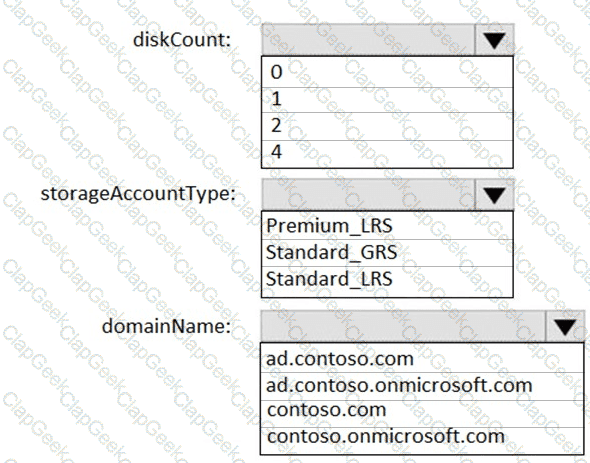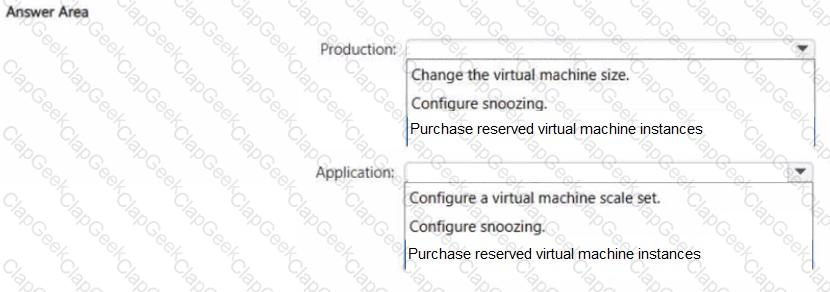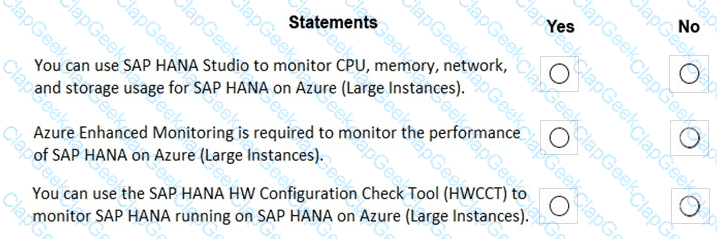You need to ensure that you can receive technical support to meet the technical requirements.
What should you deploy to Azure?
You have an on-premises SAP landscape and a hybrid Azure AD tenant. You plan to enable Azure AD authentication for SAP NetWeaver. What should you configure first in Azure AD?
You are evaluating which migration method Litware can implement based on the current environment and the business goals.
Which migration method will cause the least amount of downtime?
For each of the following statements, select Yes if the statement is true. Otherwise, select No.
NOTE: Each correct selection is worth one point.

You are evaluating the migration plan.
Licensing for which SAP product can be affected by changing the size of the virtual machines?
You are planning the Azure network infrastructure to support the disaster recovery requirements.
What is the minimum number of virtual networks required for the SAP deployed?
This question requires that you evaluate the underlined BOLD text to determine if it is correct.
You are planning for the administration of resources in Azure.
To meet the technical requirements, you must first implement Active Directory Federation Services (AD FS).
Instructions: Review the underlined text. If it makes the statement correct, select “No change is needed”. If the statement is incorrect, select the answer choice that makes the statement correct.
Before putting the SAP environment on Azure into production, which command should you run to ensure that the virtual machine disks meet the business requirements? To answer, select the appropriate options in the answer area.
NOTE: Each correct selection is worth one point.

Once the migrate completes, to which size should you set the ExpressRoute circuit to the New York office to meet the business goals and technical requirements?
You need to provide the Azure administrator with the values to complete the Azure Resource Manager template.
Which values should you provide for diskCount, StorageAccountType, and domainName? To answer, select the appropriate options in the answer area.
NOTE: Each correct selection is worth one point.

You are evaluating the proposed backup policy.
For each of the following statements, select Yes if the statement is true. otherwise, select No.
NOTE: Each correct selection is worth one point.

for each of the following statements, select Yes if the statement is true. Otherwise. select No.
NOTE: Each correct selection is worth one point.

Which Azure service should you deploy for the approval process to meet the technical requirements?
You are planning replication of the SAP HANA database for the disaster recovery environment in Azure.
For each of the following statements, select Yes if the statement is true. Otherwise, select No.
NOTE: Each correct selection is worth one point.

Your on-premises network contains an Active Directory domain.
You are deploying a new SAP environment on Azure.
You need to configure SAP Single Sign-On to ensure that users can authenticate lo SAP GUI and SAP WebGUI.
Which four actions should you perform in sequence? To answer, move the appropriate actions from the list of actions to the answer area and arrange them in the correct order.

You have an instance of SAP NANA on Azure (Large Instances) named HIM.
You plan to deploy Azure virtual machines. The virtual machines will host application servers that will access the database on HLI1.
You need to minimize latency between the application servers and HLH
What should you do? To answer, select the appropriate options m the answer area
NOTE: Each correct selection is worth one point.


You are planning an SAP NetWeaver deployment on Azure. The database her will consist of Two Azure virtual machines that have Microsoft SQL Server 2017 installed. Each virtual machine will be deployed to a separate availability zone.
You need to perform the following:
• Minimize network latency between the virtual machines.
• Measure network latency between the virtual machines.
What should you do? To answer, select the appropriate options in the answer area.
You have an SAP on Azure landscape.
You configure SAP Central Services (SCS) to write logs to Windows Event Viewer.
You need to collect the logs in Azure Monitor by using a Data Collection Rule (DCR). The solution must prevent the logs from being sent via the internet.
Which two resources should you configure? Each correct answer presents part of the solution.
NOTE: Each correct selection is worth one point.
You have an on-premises deployment of SAP HANA that contains a production environment and a development environment.
You plan to migrate both environments to Azure.
You need to identify which Azure virtual machine-series to use for each environment. The solution must meet the following requirements:
• Minimize costs.
• Be SAP HANA-certified.
What should you identify for each requirement? To answer, select the appropriate options in the answer area. NOTE: Each correct selection is worth one point.

You have an Azure virtual machine named VM1 that hosts an SAP application server.
You need to implement snoozing for VM1. The solution must meet the following requirements:
• Minimize compute costs for VM1.
• Gracefully terminate the SAP application.
What should you do? To answer, select the appropriate options in the answer area. NOTE: Each correct selection is worth one point.

You have an Azure subscription. The subscription contains two virtual machines named SQL1 and SQL2 that host a Microsoft SQL Server 2019 Always On availability group named AOG1.
You plan to deploy an SAP NetWeaver system that will have a database tier hosted on AOG1.
You need to encrypt the Azure virtual machine disks and the SQL Server database. The solution must meet the following requirements:
• The operating system disk, data disk, and the temporary disk of the virtual machines must be encrypted.
• SQL Server encryption keys must be stored on-premises.
Which type of encryption should you use? To answer, select the appropriate options in the answer area. NOTE: Each correct selection is worth one point.

You have two Azure virtual machines that host a Microsoft SQL Server 2019 failover cluster instance (FCI) named FCI1.
FCI1 hosts the database tier of an SAP NetWeaver system. The application tier connects to FCI1 by using a virtual network name (VNN) of fci1.contoso.com. Name resolution is provided by an Azure Private DNS zone.
On FCI1, you implement a distributed network name (DNN) of FCI1DNN and verify that you can connect to fci1dnn.contoso.com.
You need to ensure that the application tier can use the DNN when connecting to FCI1.
What should you do first?
You have an on-premises network and an Azure subscription.
You plan to deploy a standard three-tier SAP architecture to a new Azure virtual network.
You need to configure network isolation for the virtual network. The solution must meet the following requirements:
• Allow client access from the on-premises network to the presentation servers.
• Only allow the application servers to communicate with the database servers.
• Only allow the presentation servers to access the application servers.
• Block all other inbound traffic.
What is the minimum number of network security groups (NSGs) and subnets required? To answer, drag the appropriate number to the correct targets. Each number may be used once, more than once, or not at all. You may need to drag the split bar between panes or scroll to view content.
NOTE Each correct selection is worth one point.

You have four SAP NetWeaver servers that run on Azure virtual machines deployed across two Azure Availability Zones. You plan to deploy a load balancing solution for the SAP GUI app. What should you use?
You deploy an SAP landscape on Azure.
You plan to use an Azure Automation account to stop the SAP virtual machines outside of business hours.
You need to ensure that you can use Azure Automation runbook a for the virtual machines.
What does the Azure Automation account require?
You have an SAP production landscape on-premises and an SAP development landscape on Azure.
You deploy a network virtual appliance to act as a firewall between the Azure subnet and the on-premises network.
Solution: You configure route filters for Microsoft peering.
Does this meet the goal?
You have an SAP production landscape that uses SAP HANA databases on Azure.
You need to deploy a disaster recovery solution to the SAP HANA databases. The solution must meet the following requirements:
• Support failover between Azure regions.
• Minimize data loss in the event of a failover.
What should you deploy?
You plan to deploy an SAP environment on Azure. The SAP environment will have landscapes for production, development. and quality assurance.
You need to minimize the costs associated with running the development and quality assurance landscapes on Azure. What should you do?
You plan to deploy two SAP NetWeaver landscapes named Production1 and Production2 to Azure. Production! will contain an SAP NetWeaver central services (ASCS/SCS) instance hosted on a Windows failover cluster. Production2 will contain an SAP ASCS/SCS instance hosted on a Linux Pacemaker cluster.
You need to recommend a shared storage solution for each landscape. The solutions must meet the following requirements:
• Minimize administrative effort.
• Minimize costs.
What should you include in the recommend? To answer, select the appropriate options in the answer area. NOTE: Each correct selection is worth one point.

You have a highly available deployment of SAP NetWeaver on Azure virtual machines. The database tier is hosted on two virtual machines that run Windows Server 2019 and have Microsoft SQL Server 2017 installed. The NetWeaver, application, and database tiers each reside on a separate subnet within the same virtual network.
You run ABAPMeter against the deployment and discover that the average value of Act DB is 2 ms.
You need to lower the Acc DB value.
What should you do?
Note: This section contains one or more sets of questions with the same scenario and problem. Each question presents a unique solution to the problem. You must determine whether the solution meets the stated goals. More than one solution in the set might solve the problem. It is also possible that none of the solutions in the set solve the problem.
After you answer a question in this section, you will NOT be able to return. As a result, these questions do not appear on the Review Screen.
You have an on-premises datacenter.
You have an Azure subscription that contains a virtual network named VNet1.
You have an SAP RISE managed workload.
You need to ensure transitive connectivity between the datacenter. VNet1, and the managed workload.
Solution: You configure a Site-to-Site (S2S) VPN connection between the datacenter and VNet1 and an S2S VPN connection between VNet1 and the managed workload.
Does this meet the goal?
You plan to deploy an SAP environment on Azure that will use Azure Availability Zones.
Which load balancing solution supports the deployment?
You have an Azure subscription that contains two deployments of SAP NetWeaver on Azure named Production and Development. The Development deployment is used only during business hours and will be decommissioned after three months.
You need to recommend an optimization solution for the deployments. The solution must meet the following requirements:
• Maximize uptime of the Production deployment.
• Minimize costs, whenever possible.
What should you include in the recommendation for each deployment? To answer, select the appropriate options in the answer area.
NOTE: Each correct selection is worth one point.

You plan to migrate an SAP ERP Central Component (SAP ECC) production system to Azure.
You are reviewing the SAP EarlyWatch Alert report for the system.
You need to recommend sizes for the Azure virtual machines that will host the system.
Which two sections of the report should you review? Each correct answer presents a complete solution.
NOTE: Each correct selection is worth one point.
You deploy SAP HANA by using SAP HANA on Azure (Large Instances).
For each of the following statements, select Yes if the statement is true. Otherwise, select No.
NOTE: Each correct selection is worth one point.

You have an SAP landscape on Azure that uses SAP HANA
You perform a daily backup of HANA to Azure Blob Storage and retain copies of each backup for one year
You need to reduce the backup storage costs.
What should you implement?
You have an Azure subscription named Sub! that contains a Microsoft Sentinel workspace named Workspace1.
You have an SAP RISE managed workload that is integrated with Sub1.
You need to implement the Microsoft Sentinel solution for SAP applications in Workspace1. The solution must meet the following requirements:
• Generate an incident based on transaction codes when a sensitive SAP transaction is executed by an unauthorized user.
• When an incident is generated, send a notification to a designated Microsoft Teams channel.
• Minimize administrative effort.
What should you include in the solution? To answer, select the appropriate options in the answer area. NOTE: Each correct selection is worth one point.

You are designing a four-node SAP Web Dispatcher deployment for an SAP on Azure landscape.
You need to recommend a resiliency solution and a load-balancing solution for the deployment. The solution must meet the following requirements;
• Receive the highest SLA from Microsoft.
• Load balance client connections.
• Minimize administrative effort
What should include in the recommendation for each solution? To answer, select the appropriate options in the answer area. NOTE Each correct selection is worth one point.

You have an Azure subscription that contains a virtual network named VNET1, an SAP production landscape on Azure, and an SAP non-production landscape on Azure. Both landscapes connect to VNET1. Each landscape contains virtual machines that run the following:
• SAPHANA
• SAP NetWeaver
• Microsoft SQL Server
You need to monitor the landscapes. The solution must minimize costs.
What is the minimum number of required Azure Monitor for SAP Solutions instances?
You plan to migrate an on-premises SAP development system to Azure.
Before the migration, you need to check the usage of the source system hardware, such as CPU, memory, network, etc.
Which transaction should you run from SAP GUI?
Your company has a an on-premises SAP environment.
Recently, the company split into two companies named Litware, inc and Contoso.Ltd. Litware retained the SAP environment.
Litware plans to export data that is relevant only to Contoso. The export will be 1.5 TB.
Contoso build a new SAP environment on Azure.
You need to recommend a solution for Litware to make the data available to Contoso in Azure. The solution must meet the following requirements:
Minimize the impact on the network.
Minimize the administrative effort for Litware.
What should you include in the recommendation?
You need to implement a deployment of SAP NetWeaver on Azure. The deployment will be hosted on Esv3 virtual machines that run on dedicated hosts. The hosts will be deployed to different availability zones in a single Azure region. The solution must meet the following requirements:
• Ensure maximum availability of the dedicated hosts.
• Minimize network latency for database writes when the virtual machines run on hosts in different availability zones.
What should you use for each requirement? To answer, select the appropriate options in the answer area.
NOTE: Each correct selection is worth one point.

You have an SAP on Azure deployment that contains a production landscape and a non-production landscape.
You have the virtual machines shown in the following table.

You need to minimize the costs of the deployment for the next 12 months. The solution must meet the following requirements:
• Maintain SAP support
• Minimize application impact.
What should you do on each virtual machine? To answer, select the appropriate options in the answer area. NOTE: Each correct selection is worth one point.



